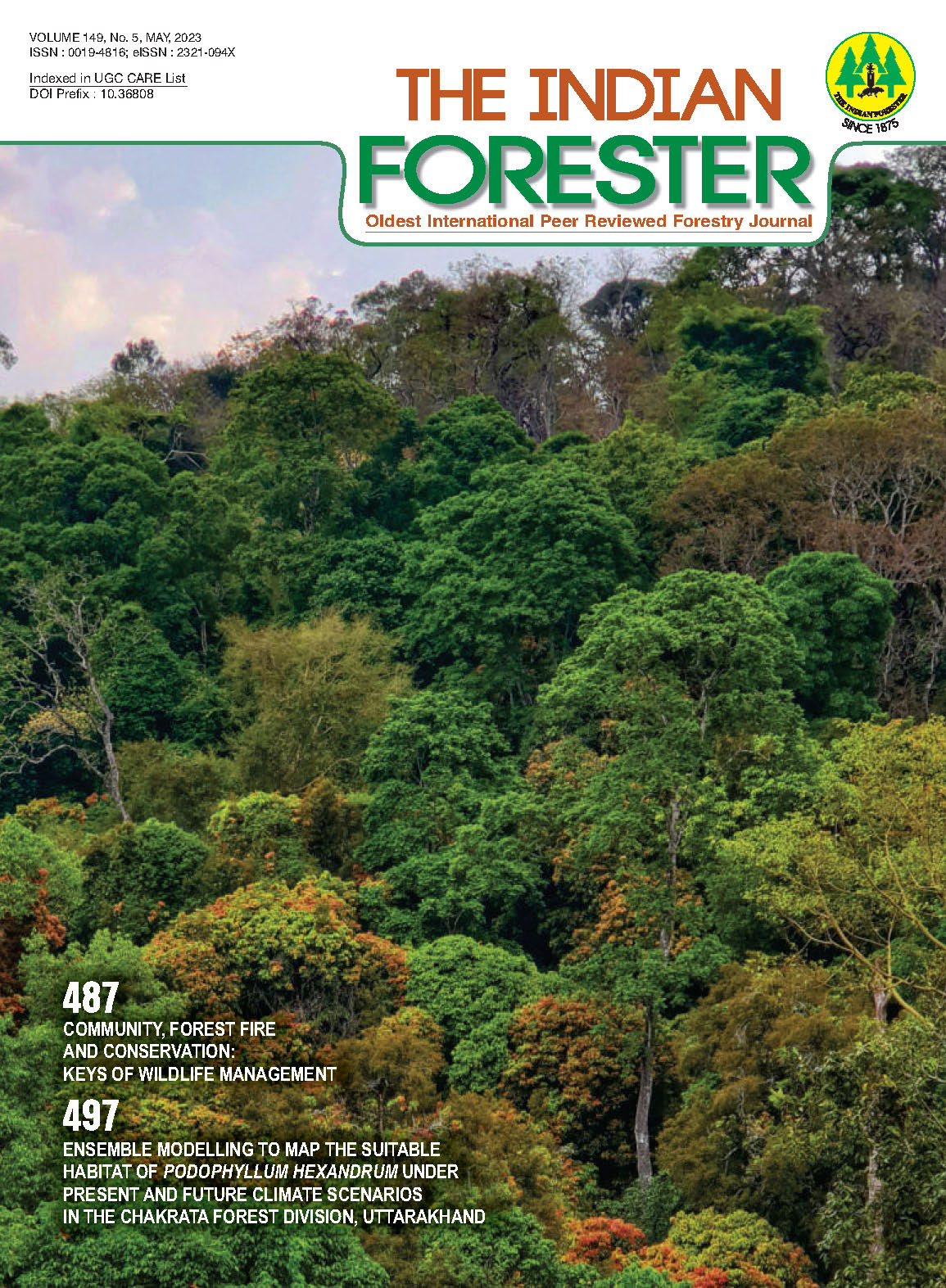Sustainable Artisanal Livelihoods and Ecology of Wood Resource Use: The Case of Traditional Toy-Making in Channapatna, South India
DOI:
https://doi.org/10.36808/if/2023/v149i5/164383Keywords:
Ivory Tree, Handicraft Industry, Agroforestry, Wood Scarcity, Resource Sustainability.Abstract
Rural artisanal livelihoods are inextricably linked to local resources and for wood carvers, easy availability of wood resources is a crucial determinant of livelihood security. Our study is focused on the sustainability of the key raw material, Wrightia tinctoria L. (ivory tree), for the famous wooden toy-making industry in Channapatna, Karnataka, South India. Our research investigated the trends in use of ivory wood and the status of Wrightia trees in farmlands. Group interactions and semi-structured interviews were conducted in seven artisanal clusters in Channapatna to elucidate livelihood implications of toy-making industry and trends in wood resource use and supply. Further, tree-growing farmers and wood traders were interviewed to trace the wood supply chain. The research highlights the critical role of ivory wood in supporting livelihoods of marginalised sections of artisans and reveals the immense pressure on local ivory wood resources. The study puts forth recommendations to ensure sustained availability of the resource.References
Aggarwal P.K., Rao R.V. and Joshi S.C. (2013). Wooden toys in India. Unasylva, 64(1), 240.
ASSOCHAM (2016). Differential duty structure a big challenge for toy industry. [accessed 5th May 2020]. https://www.assocham.org/newsdetail.php?id=5863
Ataa-Asantewaa M. (2013). Local Knowledge of Farmers on Farm Tree Management, East Shewa Zone, Ethiopia [dissertation]. Bangor University.
Belcher B. and Schreckenberg K. (2007). Commercialisation of Non-timber Forest Products: A Reality Check. Development Policy Review, 25(3): 355-377.
Braedt O. and Standa-Gunda W. (2000). Woodcraft Markets in Zimbabwe. International Tree Crops Journal, 10(4): 367-384.
Chave J., Andalo C., Brown S., Cairns M., Chambers J. and Eamus D. (2005). Tree allometry and improved estimation of carbon stocks and balance in tropical forests. Oecologia, 145(1): 87-99.
Christian M., Chirwa P. and Ham C. (2008). The influence of tourism on the woodcarving trade around Cape Town and implications for forest resources in southern Africa. Development Southern Africa, 25(5): 577-588.
CIFOR (2002). Planning for woodcarving in the 21st century.
Cropper A. and Kaimowitz D. (2005). Forests for people and the environment. Jakarta, Indonesia: CIFOR, Centre for International Forestry Research.
Cunningham A.B., Campbell B.M., Belcher B. and Belcher B.M. (Eds.). (2005). Carving out a future: Forests, livelihoods and the international woodcarving trade. Earthscan.
DGCI&S (2020). Ministry of Commerce, Government of India, Handicrafts Export Data, Commodity-wise Export Data (HS Code: 95030010, dolls of wood). [accessed 10th December 2020]. https://commerce-app.gov.in/eidb/ecom.asp
DPA (1976). The Karnataka Preservation of Trees Act. [accessed June 5 2019]. http://dpal.kar.nic.in/
FAO (2018). The State of the World's Forests. Forest Pathways to Sustainable Development. Rome.
FAO (2020). The State of the World's Forests. Forests, Biodiversity and People. Rome.
Geographical Indication Registry. (2005). Intellectual Property of India. [accessed June 25 2019]. http://ipindia.nic.in/gi.htm
IBEF (2020). Indian Handicrafts Industry & Exports. Ministry of Commerce & Industry, Government of India.
IIFM (2004). Impact of wood carving industry on Wrightia population at Budhani Village, Madhya Pradesh. Ministry of Environment, Forest and Climate Change. Government of India.
Koenig J., Altman J. and Griffiths A. (2011). Indigenous Livelihoods and Art Income: participation, production and returns from woodcarvings in Arnhem Land, north Australia. Australian Geographer, 42(4): 351-369.
Leverett B. and Bertolette D. (2015). Measuring guidelines handbook. American Forest. American forests. org/wp-content/uploads/2014/12/AF-Tree-Measuring-Guidelines_LR.
Manjunatha (2016). Working Plan for Ramanagara Territorial Division (2012-13 to 2021-22). Karnataka Forest Department.
Matose F. (2006). Access mapping and chains: The woodcraft curio market around Victoria Falls, Zimbabwe. In survival of the commons: Mounting challenges and new realities, the 11th conference of the International Association for the Study of Common Property, Bali, Indonesia.
Menon R. and Gupta S. (2011). Working Group Report on Handicrafts for the 12th Five Year Plan. Ministry of Textiles. Government of India.
MHA (1991, 2001, 2011). Office of the Registrar General & Census Commissioner, Government of India. Census India database [accessed April 10 2019]. https://censusindia.gov.in/
MOT (2020). Annual Report for 2019-20. Government of India. [accessed 15th December 2020]. http://texmin.nic.in/
NPC (2017). Research Study on Productivity & Competitiveness of Toy Manufacturing Sector in India. Department of Industrial Policy and Promotion (DIPP). Ministry of Commerce & Industry. Government of India.
Orwa C. (2009). Agroforestry Database: a tree reference and selection guide, version 4.0. [accessed April 5 2019]. http://www.worldagroforestry.org/
Page E. and Redclift M. (2002). Human Security and the Environment Publishing Inc. Cheltenham, California, Stanford University Press.
Rao M.V., Balaji M. and Joshi S.C. (2011). Etikoppaka: An Indian village perpetuating the joy of wood through the tradition of toy art. In International Conference and Exhibition on Art and Joy of Wood, held at IWSTBangalore (pp. 19-22).
Shackleton C. and Shackleton S. (2004). The importance of non-timber forest products in rural livelihood security and as safety nets: a review of evidence from South Africa. South African Journal of Science, 100(11): 658-664.
Shackleton S., Campbell B., Lotz-Sisitka H. and Shackleton C. (2008). Links between the Local Trade in Natural Products, Livelihoods and Poverty Alleviation in a Semi-Arid Region of South Africa. World Development, 36(3): 505-526.
Souza A. (2007). Ecological interpretation of multiple population size structures in trees: The case of Araucaria angustifolia in South America. Austral Ecology, 32(5): 524-533.
Sunderlin W., Dewi S., Puntodewo A., Müller D., Angelsen A. and Epprecht M. (2008). Why forests are important for global poverty alleviation: A spatial explanation. Ecology and Society, 13(2): 24.
Weterings M., Weterings-Schonck S., Vester H. and Calmé S. (2008). Senescence of Manilkara zapota trees and implications for large frugivorous birds in the Southern Yucatan Peninsula, Mexico. Forest Ecology and Management, 256(9): 1604-1611.
Downloads
Downloads
Published
How to Cite
Issue
Section
License
Unless otherwise stated, copyright or similar rights in all materials presented on the site, including graphical images, are owned by Indian Forester.





